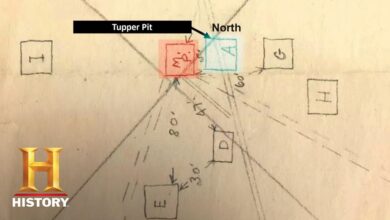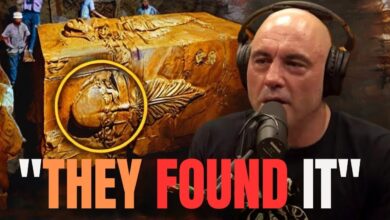The Curse of Oak Island: Ancient Roman Coin SHOCKS the Team (Season 10)
The Curse of Oak Island: Ancient Roman Coin SHOCKS the Team (Season 10)

ALEX LAGINA: Perfect.
Thanks, Jack.
Blair, Kellen, Emma.
How are you, Sandy?
So we’ll set up here.
NARRATOR: Alex Lagina, Jack Begley, and archaeometallurgist Emma Culligan welcome numismatist Sandy Campbell to the Oak Island Interpretive Center. Sandy has come to examine the cut copper coin that was found one week ago by Rick Lagina and Garry Drayton on lot five, a coin which x-ray fluorescence scanning has indicated may predate the 16th century.
ALEX LAGINA: OK.
So the thing that we’d like to show you is a find on lot five, which we’ve recently gained access to.
- OK.
Yeah.
So this is kind of a new area on the island for us.
OK.
We only recently got access to the lot, so we haven’t been over it with a metal detector, ourselves.
And that’s what Rick and Gary were doing when they found this.
It’s very interesting.
We’re not totally sure what it is, but we have some ideas.
OK.
Well, let’s have a look.
JACK BEGLEY: I’ll go grab the coin.
SANDY CAMPBELL: Great.
Perfect.
Here you go.
Thank you, Emma.
Here, I’ll hand it to you in the bag.
All right.
Let’s have a look.
Part of a coin, hopefully.
Time to look.
So you’ve done an XRF and a CT?
Yeah, we have.
Emma, are you able to pull that up for us, by any chance?
Sure can.
Thank you.
EMMA CULLIGAN: It’s just loading, right now.
While that loads, here’s a picture.
Let’s flip it to the other.
JACK BEGLEY: It looks like there’s some sort of characters or something inscribed on it.
SANDY CAMPBELL: Yeah, what about XRF?
Yes.
So I do have an XRF result.
And it shows high content in copper, lead, and tin, but also about 0.51% arsenic.
Yeah.
And it also has 1.05% silver in it, as well.
Which, yeah.
I mean, you can get silver naturally occurring with copper, obviously.
You know, if it has arsenic, this is pre-1500, for sure.
You know, if we weigh this, let’s weigh it.
This is going to tell us something.
OK.
This coin looks like there’s probably a third of it left.
JACK BEGLEY: Mm-hmm.
This is probably somewhere in the gram range, but let’s–
so it weighs exactly a gram, which, you know, is sort of unusual that it would be bang on a gram.
But you know, it’s–
Wow.
SANDY CAMPBELL: –it’s not unusual to see coins cut up and used as money in a partial payment.
Again, you know, you get a coin that’s this big, and the deal of the day required a third of that copper.
So you’re just snipping off a third of the coin, right?
Right.
And that’s really how barter worked then.
Right.
Let’s see, here.
I think this is probably– I– I’m guessing it’s either Roman.
It could even be Byzantine, but I’m thinking it’s– it’s Roman.
Roman?
No way.
SANDY CAMPBELL: Based on what I’m seeing on the coin, I mean, I– I see Roman-style characters.
The style is definitely from 300 BC to 500-600 AD.
No way.
SANDY CAMPBELL: Yeah.
NARRATOR: A Roman coin possibly dating back over 2000 years?
But if so, who could have brought it to Oak Island?
All right.
So I’m going to have to call Rick.
I want to see– I want to see Rick’s reaction.
Yeah, this is unbelievable.
[phone ringing]
RICK: Hello?
Hey, Rick.
RICK: Hey, Alex. How are you?
- Good.
Hey.
You– you and Gary might want to come down to the lab.
We got some pretty interesting information here for you.
RICK: We’ll be down ASAP.
OK.
See you soon.
RICK: All right. See you.
Yeah, bye.
This is just an incredible moment because, you know, we got– we have a Roman coin on Oak Island.
And here we sit, trying to draw conclusions.
And it’s like wide open at this point.
You know, who brought it here?
How did it get here?
Why is it on lot five, in particular?
It’s just a total mystery, right now.
Hey, Laird?
Hey.
Can you join us on this?
Sure.
I’d love to get your take.
This is like a typical-looking Roman, all the way into Byzantine period, design.
Laird, is there a precedent in Nova Scotia of, you know–
Not in Nova Scotia.
There are precedents in the East Coast of the United States–
OK.
So–
–from archaeological sites.
RICK: Hey, guys.
- Hey, chaps.
- Hey, guys.
- We heard–
Brace yourselves.
–excitement in your voices, and we came running.
Brace yourselves.
Oh.
So this is what you guys found on lot five, the other day.
And we just showed it to Sandy.
My– my thoughts, and I think I’m pretty confident, that this is Roman, most likely Roman.
Roman, baby!
Oh, have I waited for this.
Put it in probably Roman.
That’s my gut.
So what do you make of that?
That is incredible, mate.
Incredible.
RICK: Run it by me again.
Why is it possibly Roman?
Well, the design is definitely Roman.
This is definitely a person here, and this is a tree here.
Yeah.
SANDY CAMPBELL: This style is Roman.
Does the elemental analysis confirm what you suspect about the coin?
SANDY CAMPBELL: Yeah.
When I see arsenic, and I see silver in there, you know, it’s a very unrefined copper, which shows that, again, really confirms with me that it’s probably, most likely Roman.
A Roman coin on Oak Island?
What’s it doing here?
So when we were in Portugal, we were investigating the road that we found in the swamp, right?
And we saw an example of a Roman road over in Portugal.
Morning.
Welcome to Portugal.
Thank you.
NARRATOR: One year ago, Rick, Alex, and members of the team visited a number of locations in Portugal, where the Knights Templar established strongholds between the 12th and 16th centuries.
OK, let’s see what we could find.
NARRATOR: There, they were shown a number of carvings in Templar churches, matching symbols that have been found in the past on Oak Island.
This symbol is definitely on the 90-foot stone, right there.
That’s perfect.
ALEX LAGINA: Yeah.
The stone path looks exactly like this.
NARRATOR: But one of the most compelling features they saw was a cobblestone road, dating back nearly 2000 years to a time when the area was once part of the Roman Empire.
Incredibly, the road was an exact match to the one unearthed in the swamp by the team in 2020, which is believed to date back at least 500 years and be of Portuguese origin.
So maybe the coin and the road in the swamp are connected.
SANDY CAMPBELL: Yeah.
NARRATOR: Is it possible that this Roman coin may have been brought to Oak Island by members of the Knights Templar?
If so, could it also explain the possible dam feature at the north end of the swamp, the medieval, lead cross found in 2017 at Smith’s Cove, or even, perhaps, the high traces of gold that have been detected in the money pit area?
A Roman-era coin on Oak Island, it’s astounding.
It’s undeniable that there is a certain geographic connection, but is it Templar related?
I don’t know.
We have to put it through more rigorous, scientific analysis.
This story is incredibly complex.
I know one thing for sure.
Lot five is now on the Oak Island treasure map, for sure.
Yeah.
Sandy, you know, we welcome your expertise.
And if you can continue to look into this–
I will.
–we would love whatever information comes of that.
And we need to get back out to lot five.
We do, mate.
Boots on the ground, as you would say.
Yeah.
Thank you very much.








